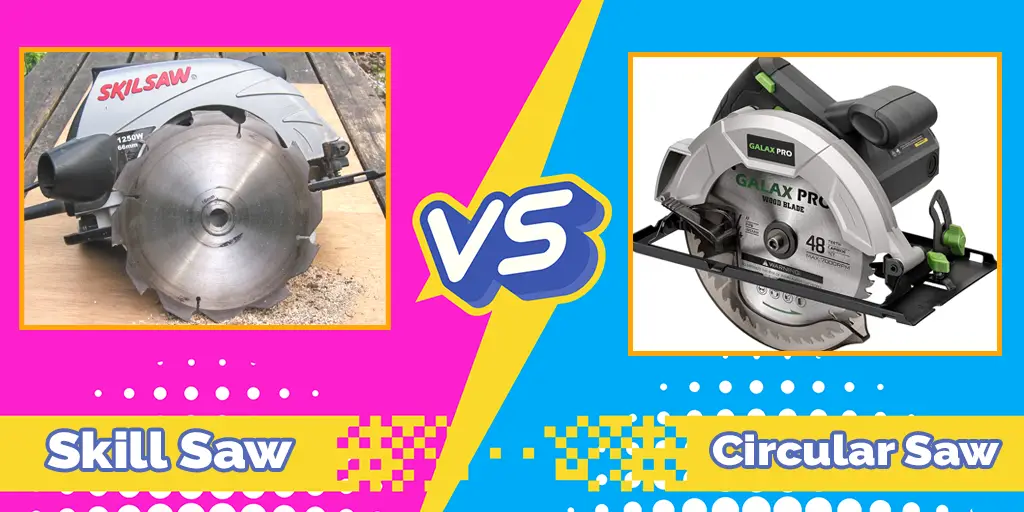For woodworking professionals and DIY enthusiasts alike, the circular saw stands as an indispensable tool in the arsenal.
Renowned for its versatility and efficiency, this tool has become a cornerstone in workshops across the globe.

However, amidst its widespread use, a common query often surfaces: what exactly sets a Skill Saw apart from a standard circular saw?
In this comprehensive guide, we delve deep into the world of circular saws, unraveling the intricacies that distinguish a Skill Saw from its counterparts.
Whether you’re a seasoned woodworker or a curious hobbyist, this article is designed to shed light on these tools’ subtle differences and historical backgrounds, ensuring you’re well-equipped to make an informed decision for your next project.
Key Takeaways:
- Understanding the core functions of circular saws.
- Exploring the origins of the term “Skill Saw.”
- Providing clarity on the Skill Saw vs Circular Saw debate.
Let’s cut through the confusion and set the record straight.
The Circular Saw and the Skill Saw
What is a Circular Saw?
A circular saw, at its core, is a power tool equipped with a toothed or abrasive disc or blade to cut different materials using a rotary motion spinning around an arbor.
A hallmark of versatility, circular saws are used to make straight cuts through various materials, including wood, plastic, metal, and masonry.
This tool’s defining characteristic is its portability and the ability to handle diverse cutting tasks with precision and ease.
Key Characteristics:
- Portability: Easy to handle and move around.
- Versatility: Suitable for cutting a range of materials.
- Precision: Allows for accurate and straight cuts.
The Skill Saw: A Circular Saw by Another Name
The term “Skill Saw” originated from the Skilsaw brand, which introduced one of the first handheld circular saws. Over time, the brand name became synonymous with circular saws in general.
Today, when someone mentions a Skill Saw, they are often referring to a standard circular saw, albeit sometimes specifically those manufactured by the Skilsaw brand.
Brand Legacy:
- Skilsaw Brand: The pioneer in handheld circular saws.
- Synonymous Usage: “Skill Saw” often used interchangeably with circular saws.
Understanding the Connection:
- Brand Identity vs. Generic Term: The name “Skill Saw” blurs the line between brand identity and a generic term for circular saws.
In this section, we have established the basic understanding of what circular saws are and how the term “Skill Saw” came to be.
It’s crucial to recognize that, while there might be subtle differences based on brand and model, the foundational concept remains the same.
Comparative Analysis: Skill Saw vs Circular Saw
When it comes to comparing a Skill Saw with a Circular Saw from another brand, the distinctions often lie in the finer details rather than the fundamental functionality.
To illustrate this, let’s take a closer look at two specific models: the Skil SPT77WML-01 (representing the Skill Saw) and the Dewalt DWS535B (as an example of another popular circular saw).
Comparative Features of Skill Saw and Circular Saw
| Feature | Skil SPT77WML-01 (Skill Saw) | Dewalt DWS535B (Circular Saw) |
|---|---|---|
| Power Source | Electrical | Electrical |
| Voltage | 120 Volts | 120 Volts |
| Amperes | 15 Amps | 15 Amps |
| Dimensions | 8.75-in X 7.75-in X 20.5-in | 8.88-in X 8.63-in X 21.81-in |
| Length of Blade | 4 inches | 4 inches |
| Style of Machine | Worm Driven Circular Saw | Worm Driven Circular Saw |
| Standard Blade Size | 7-1/4 inch | 7-1/4 inch |
| Bevel Function | Yes | Yes |
| Degree of Bevel Function | 53 degrees | 53 degrees |
| Cross Cuts with Guidance | Yes | Yes |
| Angled Cuts with Guidance | Yes | Yes |
| Bevel Cuts | Yes | Yes |
| Construction Material | Magnesium and Aluminium | Magnesium and Aluminium |
Analysis of Differences:
- Dimensions: While the sizes are quite similar, the Skill Saw is slightly more compact.
- Design Characteristics: Both saws are worm-driven, which indicates a focus on power and durability.
Conclusion from Comparison:
- The differences between these two models are minimal and largely concern dimensions and minor design elements. Fundamentally, both serve the same purpose and offer similar features.
This comparative analysis underscores the fact that a Skill Saw is essentially a circular saw, with differences being more about brand-specific design choices rather than any significant divergence in function or performance.
Professional and Home Use: A Different Perspective

Design of Home Circular Saw Vs. Professional Skill Saw
The design nuances between circular saws intended for professional use and those geared towards home users are subtle yet significant.
Professional circular saws, often branded as Skill Saws, showcase design elements tailored to frequent, heavy-duty use. This includes ergonomic considerations like handle placement and grip design.
Key Design Differences:
- Handle and Grip: Professional saws have handles and grips that are positioned to offer better control and comfort during extended use, crucial for professionals who use these tools for longer periods.
- Durability: Enhanced durability is a hallmark of professional saws, as they’re built to withstand rigorous, daily use.
Size of Home Circular Saw Vs. Professional Skill Saw
Size and motor power play a pivotal role in distinguishing professional-grade saws from those meant for home use.
Professional circular saws are generally larger, accommodating bigger and more powerful motors. This is in response to the demanding nature of professional woodworking and construction tasks.
Size Comparison:
- Motor Size: Professional saws often have larger, more robust motors to handle intensive cutting tasks.
- Overall Size: Typically, professional saws are bulkier, which, while adding to the weight, also contributes to stability and power.
Historical Difference Between Skill Saw And Circular Saw
Tracing the lineage of the circular saw sheds light on the evolution of the tool from large milling machines to the compact, handheld versions we see today.
Understanding this historical context enriches our appreciation of the modern circular saw and its variants.
Circular Saws in History:
- Origin: The first circular saws date back to the 1800s, initially used in large-scale lumber milling operations.
- Evolution: The transformation from bulky, stationary machines to portable, electric-powered tools.
The Birth of the Skill Saw:
- First Electrical Hand Saw: Invented in 1923 by Edmond Michel, the first electrical hand saw marked the beginning of the modern circular saw era.
- Skilsaw Brand: The term “Skill Saw” originated from this pioneering invention, as it became a popular and widely recognized brand.
In summary, while professional Skill Saws and home-use circular saws may share fundamental functionalities, they differ in design, size, and power to cater to their respective user groups’ needs.
This differentiation is rooted not only in modern manufacturing practices but also in the historical development of these essential tools.
The Historical Journey: From Saw Mills to Handheld Devices
The story of the circular saw is a fascinating journey from its humble beginnings in the sawmills of the 1800s to the compact, powerful tools in the hands of craftsmen and DIY enthusiasts today.
This historical context not only provides a deeper understanding of the tool’s evolution but also highlights the significant milestones in its development.
Circular Saws in History
The circular saw’s origins can be traced back to the 1800s, when the first models were massive, stationary machines used primarily in lumber milling.
These early saws were the forerunners of today’s models, laying the groundwork for the development of more sophisticated and versatile tools.
Key Historical Points:
- Initial Design: Originally large, cumbersome machines designed for industrial-scale woodcutting.
- Inspiration: Tabitha Babbit, often credited with inspiring the design of the first circular saws, revolutionized woodcutting in the milling industry.
The Birth of the Skill Saw
The transition from large-scale milling machines to handheld devices began with Edmond Michel’s invention of the first electrical hand saw in 1923.
This innovation marked a significant turning point in the circular saw’s history, paving the way for the modern, portable versions.
Milestones in the Skill Saw’s History:
- First Electrical Hand Saw: Introduced by Edmond Michel in 1923, it revolutionized the concept of portable power tools.
- Formation of SKILSAW Incorporated: In 1926, following Michel’s departure, the company was rebranded to reflect its focus on the Skill Saw.
This journey from the early saw mills to today’s handheld devices illustrates the circular saw’s remarkable evolution.
It’s a testament to human ingenuity and the relentless pursuit of efficiency and convenience in tools and machinery.
People who want to read this article:
Modern Day Circular Saws and Skill Saws
The contemporary world of circular saws is a rich landscape of innovation, variety, and technological advancement, heavily influenced by the legacy of the original Skill Saw.
Today, these tools are more than just cutting devices; they embody precision, versatility, and a reflection of the user’s needs, whether for professional construction or home DIY projects.
The Evolution of the Circular Saw
Modern circular saws have evolved significantly from their early predecessors. They are now more compact, powerful, and user-friendly, thanks to advancements in motor technology, materials, and ergonomic design.
Key Advancements:
- Compact and Lightweight Designs: Modern saws are designed to be easy to handle and maneuver.
- Enhanced Safety Features: Incorporation of safety mechanisms like blade guards and automatic shut-offs.
- Improved Power and Efficiency: Advances in motor technology have led to more powerful yet energy-efficient models.
The Skill Saw in the Modern Context
The Skill Saw brand, a trailblazer in the field, continues to influence the design and functionality of contemporary circular saws.
While the name “Skill Saw” is often used synonymously with any circular saw, the brand itself has maintained a reputation for quality and innovation.
Brand Influence:
- Continued Innovation: Skill Saw continues to introduce new models with advanced features, staying at the forefront of the industry.
- Brand Legacy: The name remains a hallmark of quality and reliability in the circular saw market.
Current Market Landscape
Today’s market offers a wide array of circular saws, catering to diverse needs and preferences.
From lightweight, cordless models for easy transport and use to heavy-duty, worm drive saws for demanding tasks, there’s a circular saw for every scenario.
Diverse Offerings:
- Range of Models: There are saws designed for every level of skill and type of use, from amateur DIYers to professional builders.
- Innovative Features: Features like laser guides for precision cutting, dust blowers for a clear line of sight, and variable speed controls enhance usability.
Conclusion
In essence, while the electrical handheld saw known as the Skill Saw and a circular saw are fundamentally the same type of machine, their distinction lies in their historical evolution, from large commercial milling machines to the modern, versatile tools we use today.
The term “Skill Saw,” initially a brand name, has become synonymous with circular saws, yet today’s market reveals a variety of models and features that reflect both this rich history and the ever-evolving needs of users.
Final Thoughts:
- Choosing the Right Saw: When selecting a circular saw, consider both its historical significance and the specific features that meet your needs.
- Appreciation for Evolution: Understanding the journey from the original Skill Saw to today’s diverse offerings can enhance your appreciation and usage of these remarkable tools.



